Urban Expansion Was the Main Driving Force for the Decline in Ecosystem Services in Hainan Island during 1980–2015
Abstract
:1. Introduction
2. Materials and Methods
2.1. Study Area
2.2. Data Sources
2.3. Methods
2.3.1. Optimal Granularity of Ecosystem Type
2.3.2. Water Retention
2.3.3. Water Retention
2.3.4. Carbon Sequestration
2.3.5. Oxygen Release
2.3.6. Importance Analysis
3. Results
3.1. Optimal Analysis Granularity of the Ecosystem Pattern
3.2. Change in Ecosystem Type
3.3. Spatial and Temporal Characteristics of Ecosystem Services
3.4. Drive Analysis
3.4.1. Drive Analysis of Human Activities
3.4.2. Drive Analysis of Natural Factors
4. Discussions
4.1. Comparison of Ecosystem Services with Previous Estimates
4.2. Driving Forces of Ecosystem Services
4.3. Limitations
5. Conclusions
Author Contributions
Funding
Institutional Review Board Statement
Informed Consent Statement
Data Availability Statement
Conflicts of Interest
References
- Ouyang, Z.; Zhao, T.; Zhao, J.; Xiao, H.; Wang, X. Ecological regulation services of Hainan Island ecosystem and their valuation. Chin. J. Appl. Ecol. 2004, 15, 1395–1402. (In Chinese) [Google Scholar]
- Zhang, H.; Xiao, Y. Planning island sustainable development policy based on the theory of ecosystem services: A case study of Zhoushan Archipelago, East China. Isl. Stud. J. 2020, 15, 237–252. [Google Scholar] [CrossRef]
- Xu, D.; Yang, F.; Yu, L.; Zhou, Y.; Li, H.; Ma, J.; Huang, J.; Wei, J.; Xu, Y.; Zhang, C.; et al. Quantization of the coupling mechanism between eco-environmental quality and urbanization from multisource remote sensing data. J. Clean. Prod. 2021, 321, 128948. [Google Scholar] [CrossRef]
- Xu, D.; Cheng, J.; Xu, S.; Geng, J.; Yang, F.; Xu, J.; Wang, S.; Wang, Y.; Huang, J.; Zhang, R.; et al. Understanding the Relationship between China's Eco-Environmental Quality and Urbanization Using Multisource Remote Sensing Data. Remote Sens. 2022, 14, 198. [Google Scholar] [CrossRef]
- McKinney, M.L. Effects of urbanization on species richness: A review of plants and animals. Urban Ecosyst. 2008, 11, 161–176. [Google Scholar] [CrossRef]
- Gu, C.; Hu, L.; Zhang, X.; Wang, X.; Guo, J. Climate change and urbanization in the Yangtze River Delta. Habitat Int. 2011, 35, 544–552. [Google Scholar] [CrossRef]
- Li, Y.; Li, Y.; Zhou, Y.; Shi, Y.; Zhu, X. Investigation of a coupling model of coordination between urbanization and the environment. J. Environ. Manag. 2012, 98, 127–133. [Google Scholar] [CrossRef] [PubMed]
- Zeng, D.Z.; Zeng, D.Z. How Do Special Economic Zones and Industrial Clusters Drive China’s Rapid Development? World Bank: Washington, DC, USA, 2011. [Google Scholar]
- Moenardy, D.F. Hainan province as the new free trade port. Turk. J. Comput. Math. Educ. (TURCOMAT) 2021, 12, 487–494. [Google Scholar]
- Asbjornsen, H.; Ashton, M.S.; Vogt, D.J.; Palacios, S. Effects of habitat fragmentation on the buffering capacity of edge environments in a seasonally dry tropical oak forest ecosystem in Oaxaca, Mexico. Agric. Ecosyst. Environ. 2004, 103, 481–495. [Google Scholar] [CrossRef]
- Millennium Ecosystem Assessment (MEA). Ecosystems and Human Being: A Framework for Assessment; Island Press: Washington, DC, USA, 2003. [Google Scholar]
- Wu, J. Landscape sustainability science: Ecosystem services and human well-being in changing landscapes. Landsc. Ecol. 2013, 28, 999–1023. [Google Scholar] [CrossRef]
- Xiao, Y.; Xiao, Q. Identifying key areas of ecosystem services potential to improve ecological management in Chongqing City, southwest China. Environ. Monit. Assess. 2018, 190, 258. [Google Scholar] [CrossRef] [PubMed]
- Wallace, K.J. Classification of ecosystem services: Problems and solutions. Biol. Conserv. 2007, 139, 235–246. [Google Scholar] [CrossRef]
- Fu, B.; Zhang, L. Land-use change and ecosystem services: Concepts, methods and progress. Prog. Geogr. 2014, 33, 441–446. (In Chinese) [Google Scholar] [CrossRef]
- Zhang, H.; Xiao, Y.; Deng, Y.Z. Island ecosystem evaluation and sustainable development strategies: A case study of the Zhoushan Archipelago. Glob. Ecol. Conserv. 2021, 28, e01603. [Google Scholar] [CrossRef]
- Lin, G.; Jiang, D.; Fu, J.; Zhao, Y. A Review on the Overall Optimization of Production–Living–Ecological Space: Theoretical Basis and Conceptual Framework. Land 2022, 11, 345. [Google Scholar] [CrossRef]
- Frazier, A.E.; Bryan, B.A.; Buyantuev, A.; Chen, L.; Echeverria, C.; Jia, P.; Liu, L.; Li, Q.; Ouyang, Z.; Wu, J.; et al. Ecological civilization: Perspectives from landscape ecology and landscape sustainability science. Landscape Ecology 2019, 34, 1–8. [Google Scholar] [CrossRef]
- Wang, D.; Zheng, H.; Ouyang, Z. Ecosystem services supply and consumption and their relationships with human well-being. Chin. J. Appl. Ecol. 2013, 24, 1747–1753. (In Chinese) [Google Scholar]
- Gonzalez-Redin, J.; Luque, S.; Poggio, L.; Smith, R.; Gimona, A. Spatial Bayesian belief networks as a planning decision tool for mapping ecosystem services trade-offs on forested landscapes. Environ. Res. 2016, 144, 15–26. [Google Scholar] [CrossRef] [PubMed]
- Ouyang, Z.; Zheng, H.; Xiao, Y.; Polasky, S.; Liu, J.; Xu, W.; Wang, Q.; Zhang, L.; Xiao, Y.; Rao, E.M.; et al. Improvements in ecosystem services from investments in natural capital. Science 2016, 352, 1455–1459. [Google Scholar] [CrossRef] [PubMed]
- Niu, X.; Wang, B.; Liu, S.; Liu, C.; Wei, W.; Kauppi, P.E. Economical assessment of forest ecosystem services in China: Characteristics and implications. Ecol. Complex. 2012, 11, 1–11. [Google Scholar] [CrossRef]
- Hou, P.; Zhai, J.; Cao, W.; Yang, M.; Cai, M.; Li, J. Evaluation on ecosystem changes and protection of the national key ecological function zones in mountainous areas of central Hainan Island. Acta Geogr. Sin. 2018, 73, 429–441. (In Chinese) [Google Scholar]
- Chen, B.; Lin, M.; Zhou, G.; Li, G.; Ceng, Q. Ecohydrological effect of tropical mountain rainforest in Jianfengling, Hainan, China. Acta Ecol. Sin. 2000, 20, 423–429. (In Chinese) [Google Scholar]
- Lei, J.; Chen, Z.; Chen, X.; Li, Y.; Wu, H. Spatiotemporal changes in land use and ecosystem service values on Hainan Island from 1980 to 2018. Acta Ecol. Sin. 2020, 40, 4760–4773. (In Chinese) [Google Scholar] [CrossRef]
- Jia, Y.; Liu, Y.; Zhang, S. Evaluation of agricultural ecosystem service value in arid and semiarid regions of northwest China based on the equivalent factor method. Environ. Process. 2021, 8, 713–727. [Google Scholar] [CrossRef]
- Xiao, Y.; Xiong, Q.L.; Pan, K.W. What is left for our next generation? Integrating ecosystem services into regional policy planning in the Three Gorges Reservoir Area of China. Sustainability 2019, 11, 3. [Google Scholar] [CrossRef]
- Li, A.; Ye, C.; Zhu, L.; Wang, Y.; Liang, X.; Zou, Y. Impact of land use/cover change on water production service function: The case of Hainan Tropical Rainforest National Park. Water Resour. Hydropower Technol. 2022, 53, 36–45, (In Chinese and English). [Google Scholar]
- Lei, J.R.; Chen, Y.Q.; Chen, Z.C.; Chen, S.H.; Wu, T.T.; Li, Y.L. Spatial and temporal evolution of habitat quality in three major watersheds of Hainan Island based on the InVEST model. J. Appl. Ecol. 2022, 33, 2511–2520. [Google Scholar]
- Chen, X.; Ishwaran, H. Random forests for genomic data analysis. Genomics 2012, 99, 323–329. [Google Scholar] [CrossRef] [Green Version]
- Hu, H.; Wang, S.; He, J. Comparative advantages of free trade port construction in shanghai under the belt and road initiative. Int. J. Financ. Stud. 2020, 8, 6. [Google Scholar] [CrossRef] [Green Version]
- Yang, J.; Zhang, X.; Yang, X. Evaluation of the Development Potential of Hainan Free Trade Port Industrial Chain Driven by the Internet of Things Distribution Mechanism. Comput. Intell. Neurosci. 2022, 2022, 8146926. [Google Scholar] [CrossRef]
- Liang, G. A study of the genesis of Hainan Island. Geol. China 2018, 45, 693–705. [Google Scholar]
- Liu, J.; Michalski, J.R.; Tan, W.; He, H.; Ye, B.; Xiao, L. Anoxic chemical weathering under a reducing greenhouse on early Mars. Nat. Astron. 2021, 5, 503–509. [Google Scholar] [CrossRef]
- Wang, C. Hainan Climate; Meteorological Press: Beijing, China, 2014. (In Chinese) [Google Scholar]
- Li, L.; Tang, H.; Lei, J.; Song, X. Spatial autocorrelation in land use type and ecosystem service value in Hainan Tropical Rain Forest National Park. Ecol. Indic. 2022, 137, 108727. [Google Scholar] [CrossRef]
- De Leo, G.A.; Levin, S. The multifaceted aspects of ecosystem integrity. Conserv. Ecol. 1997, 1, 3. [Google Scholar] [CrossRef]
- Zhang, M.; Zhang, J.; Liu, S.; Che, X.; Li, W. Characteristics of climate change in Hainan Island from 1961 to 2011. J. Trop. Crops 2014, 35, 2488–2495. (In Chinese) [Google Scholar]
- Liu, C.; Zhang, H.; Li, Q. Temporal and spatial variation characteristics of human activity intensity in Hainan Island from 1980 to 2018 and its driving mechanism. Adv. Geogr. Sci. 2020, 39, 567–576. (In Chinese) [Google Scholar]
- Kuang, W.; Liu, J.; Dong, J.; Chi, W.; Zhang, C. The rapid and massive urban and industrial land expansions in China between 1990 and 2010: A CLUD-based analysis of their trajectories, patterns, and drivers. Landsc. Urban Plan. 2016, 145, 21–33. [Google Scholar] [CrossRef]
- Piao, S.L.; Fang, J.Y.; Guo, Q.H. Application of CASA model to the estimation of Chinese terrestrial net primary productivity. Chin. J. Plant Ecol. 2001, 25, 603. [Google Scholar]
- Williams, D.L.; Goward, S.; Arvidson, T. Landsat. Photogramm. Eng. Remote Sens. 2006, 72, 1171–1178. [Google Scholar] [CrossRef]
- Johnston, K.; Ver Hoef, J.M.; Krivoruchko, K.; Luca, N. Using ArcGIS Geostatistical Analyst; Esri: Redlands, CA, USA, 2001. [Google Scholar]
- Gorelick, N.; Hancher, M.; Dixon, M.; Ilyushchenko, S.; Thau, D.; Moore, R. Google Earth Engine: Planetary-scale geospatial analysis for everyone. Remote Sens. Environ. 2017, 202, 18–27. [Google Scholar] [CrossRef]
- Abatzoglou, J.T.; Dobrowski, S.Z.; Parks, S.A.; Hegewisch, K.C. Terra Climate, a high-resolution global dataset of monthly climate and climatic water balance from 1958–2015. Sci. Data 2018, 5, 170191. [Google Scholar] [CrossRef]
- Mayer, A.L.; Rietkerk, M. The dynamic regime concept for ecosystem management and restoration. BioScience 2004, 54, 1013–1020. [Google Scholar]
- Fonseca, M.; Whitfield, P.E.; Kelly, N.M.; Bell, S.S. Modelling seagrass landscape pattern and associated ecological attributes. Ecol. Appl. 2002, 12, 218–237. [Google Scholar]
- Briscoe, G.; Sadedin, S.; De Wilde, P. Digital ecosystems: Ecosystem-oriented architectures. Nat. Comput. 2011, 10, 1143–1194. [Google Scholar] [CrossRef] [Green Version]
- Guan, D.; Jiang, Y.; Cheng, L. How can the landscape ecological security pattern be quantitatively optimized and effectively evaluated? An integrated analysis with the granularity inverse method and landscape indicators. Environ. Sci. Pollut. Res. 2022, 29, 41590–41616. [Google Scholar] [CrossRef]
- Curto, J.D.; Pinto, J.C. The coefficient of variation asymptotic distribution in the case of noniid random variables. J. Appl. Stat. 2009, 36, 21–32. [Google Scholar] [CrossRef]
- Jalilibal, Z.; Amiri, A.; Castagliola, P.; Khoo, M.B.C. Monitoring the coefficient of variation: A literature review. Comput. Ind. Eng. 2021, 161, 107600. [Google Scholar] [CrossRef]
- Tian, P.; Cao, L.; Li, J.; Pu, R.; Shi, X.; Wang, L.; Liu, R.; Xu, H.; Tong, C.; Zhou, Z.; et al. Landscape grain effect in Yancheng coastal wetland and its response to landscape changes. Int. J. Environ. Res. Public Health 2019, 16, 2225. [Google Scholar] [CrossRef] [Green Version]
- Song, Y.; Zhang, Z.; Niu, B.; Li, X. Temporal and spatial patterns of landscape pattern vulnerability in the Yellow River Delta from 2005–2018. Soil Water Conserv. Bull. 2021, 41, 258–266. [Google Scholar] [CrossRef]
- Wilder, T.C.; Rheinhardt, R.D.; Noble, C.V. A Regional Guidebook for Applying the Hydrogeomorphic Approach to Assessing Wetland Functions of Forested Wetlands in Alluvial Valleys of the Coastal Plain of the Southeastern United States; Engineer Research And Development Center Vicksburg Ms Environmental Lab: Vicksburg, MS, USA, 2013. [Google Scholar]
- Zeng, C.; Qi, W.; Mao, Y.; Liu, R. Study on Water Conservation Ecological Service Function and Its Value Response Mechanism in Nested Area of Water Conservancy Project. Front. Environ. Sci. 2022, 10, 887040. [Google Scholar] [CrossRef]
- Xiao, Y.; Xiong, Q.L.; Liang, P.H.; Xiao, Q. Potential risk to water resources under eco-restoration policy and global change in the Tibetan Plateau. Environ. Res. Lett. 2021, 16, 094004. [Google Scholar] [CrossRef]
- Rao, E.; Xiao, Y.; Ouyang, Z. Spatial characteristics of soil conservation service and its impact factors in Hainan Island. Acta Ecol. Sin. 2013, 33, 746–755. (In Chinese) [Google Scholar]
- Renard, K.G. Predicting Soil Erosion by Water: A Guide to Conservation Planning with the Revised Universal Soil Loss Equation (RUSLE); Handbook No. 703; U.S. Department of Agriculture: Washington, DC, USA, 1997. [Google Scholar]
- Xiao, Y.; Xiao, Q.; Xiong, Q.; Yang, Z. Effects of ecological restoration measures on soil erosion risk in the Three Gorges Reservoir area since the 1980s. GeoHealth 2020, 4, e2020GH000274. [Google Scholar] [CrossRef] [PubMed]
- Xiao, Y.; Ouyang, Z.Y.; Xu, W.H.; Xiao, Y.; Zheng, H.; Xian, C.F. Optimizing hotspot areas for ecological planning and management based on biodiversity and ecosystem services. Chin. Geogr. Sci. 2016, 26, 256–269. [Google Scholar] [CrossRef]
- Strobl, C.; Boulesteix, A.L.; Zeileis, A.; Hothorn, T. Bias in random forest variable importance measures: Illustrations, sources and a solution. BMC Bioinform. 2007, 8, 25. [Google Scholar] [CrossRef] [Green Version]
- Archer, K.J.; Kimes, R.V. Empirical characterization of random forest variable importance measures. Comput. Stat. Data Anal. 2008, 52, 2249–2260. [Google Scholar] [CrossRef]
- Wu, X.; Shi, W.; Tao, F. Estimations of forest water retention across China from an observation site-scale to a national-scale. Ecol. Indic. 2021, 132, 108274. [Google Scholar] [CrossRef]
- Yang, X.; Ouyang, Z. Spatial-temporal Patterns and Driving Forces of Water Retention Service in China. Chin. Geogr. Sci. 2019, 29, 100–111. [Google Scholar]
- Chen, S.T.; Huang, Y.; Zou, J.W.; Shi, J.W.; Lu, Y.Y.; Zhang, W.; Hu, Z.H. Interannual variability in soil respiration from terrestrial ecosystem in China and its response to climate change. Sci. China Earth Sci. 2012, 55, 2091–2098. [Google Scholar] [CrossRef]
- Tang, X.; Zhao, X.; Bai, Y.; Tang, Z.; Wang, W.; Zhao, Y.; Wan, H.; Xie, Z.; Shi, X.; Wu, B. Carbon pools in China’s terrestrial ecosystems: New estimates based on an intensive field survey. Proc. Natl. Acad. Sci. USA 2018, 115, 4021–4026. [Google Scholar] [CrossRef] [PubMed] [Green Version]
- Jandl, R.; Lindner, M.; Vesterdal, L.; Bauwens, B.; Baritz, R.; Hagedorn, F.; Johnson, D.W.; Minkkinen, K.; Byrne, K.A. How strongly can forest management influence soil carbon sequestration? Geoderma 2007, 137, 253–268. [Google Scholar] [CrossRef]
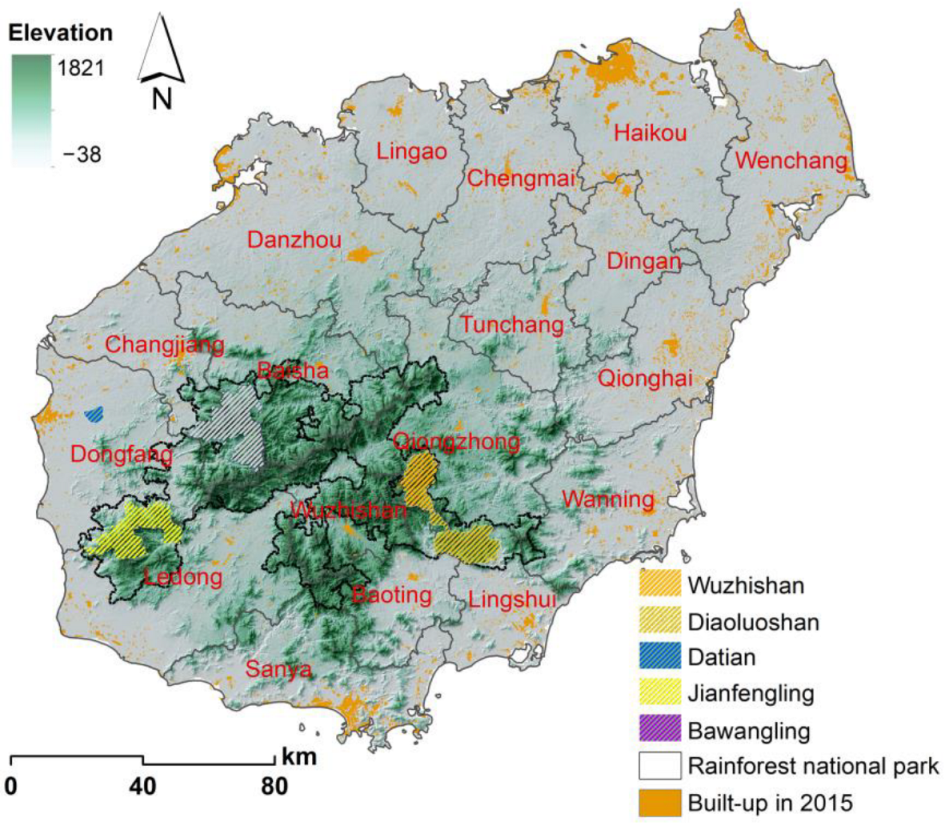
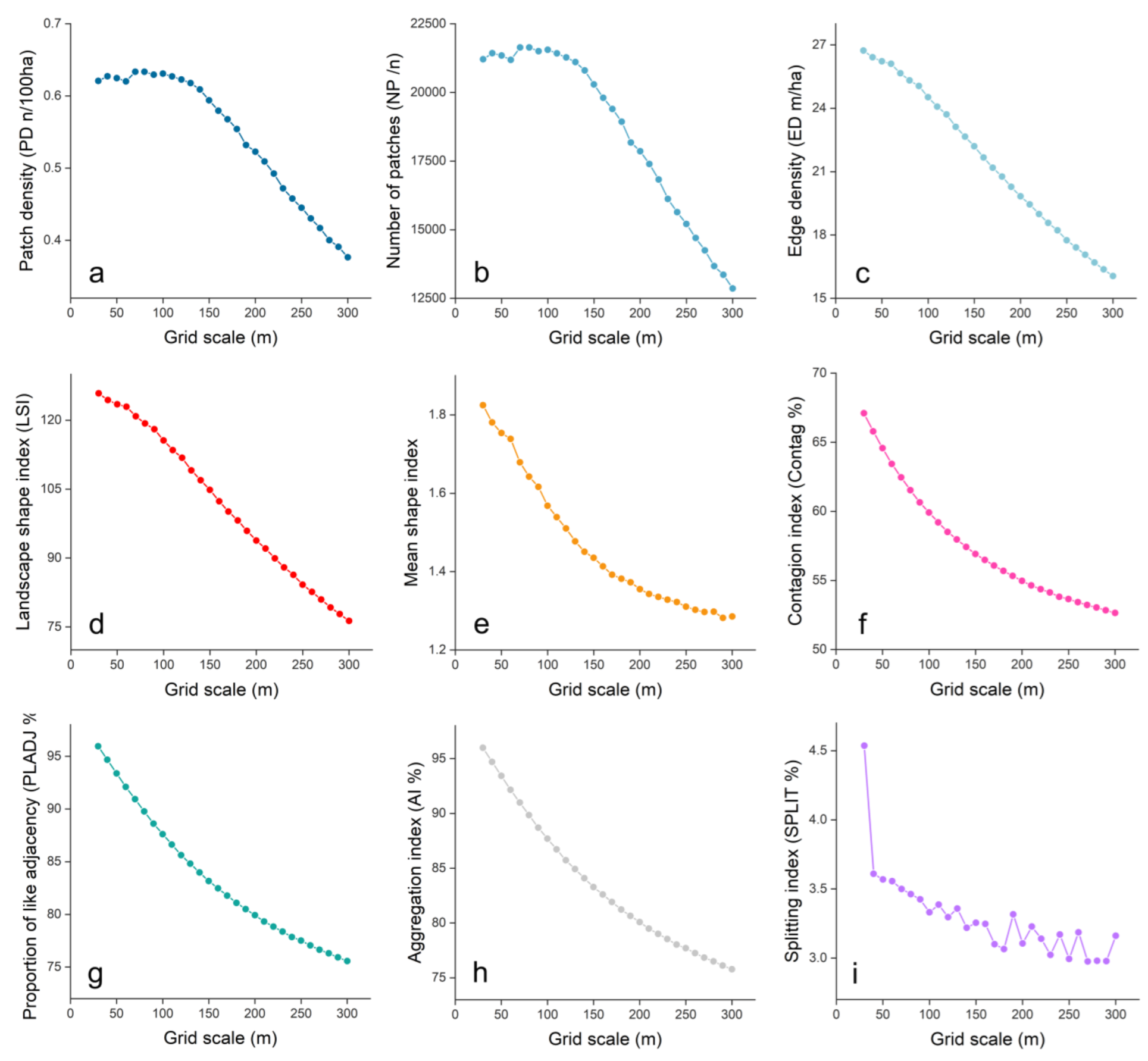
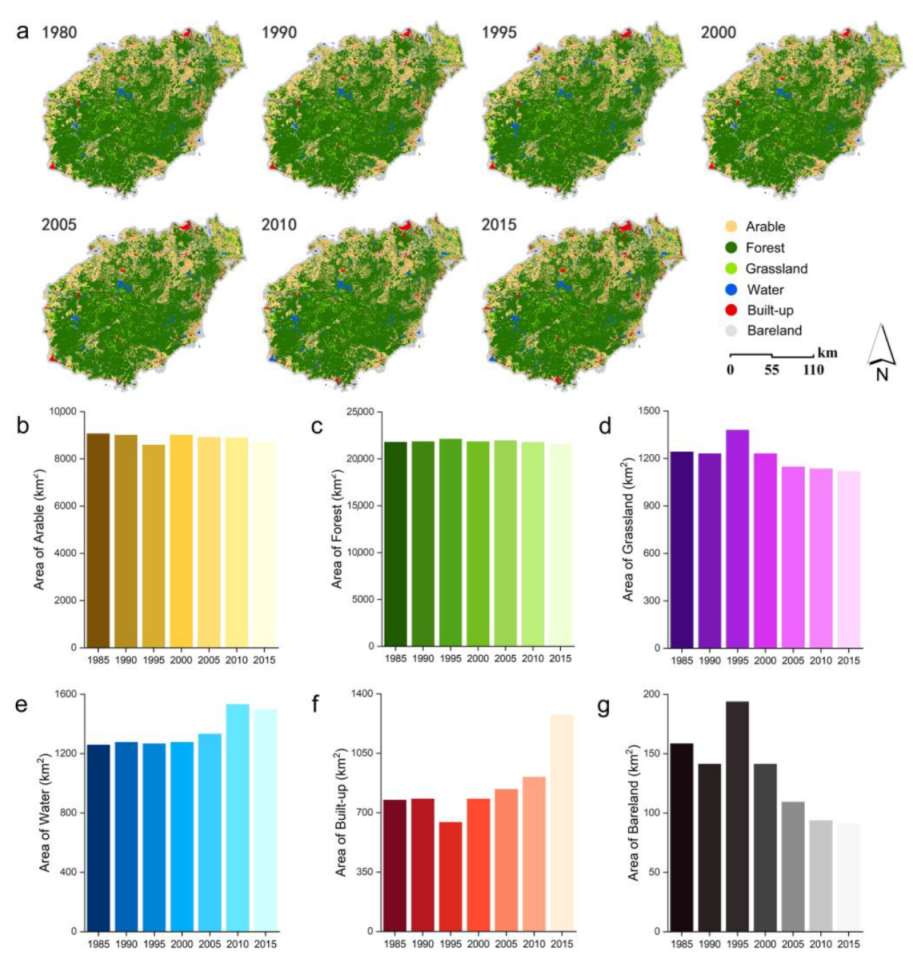

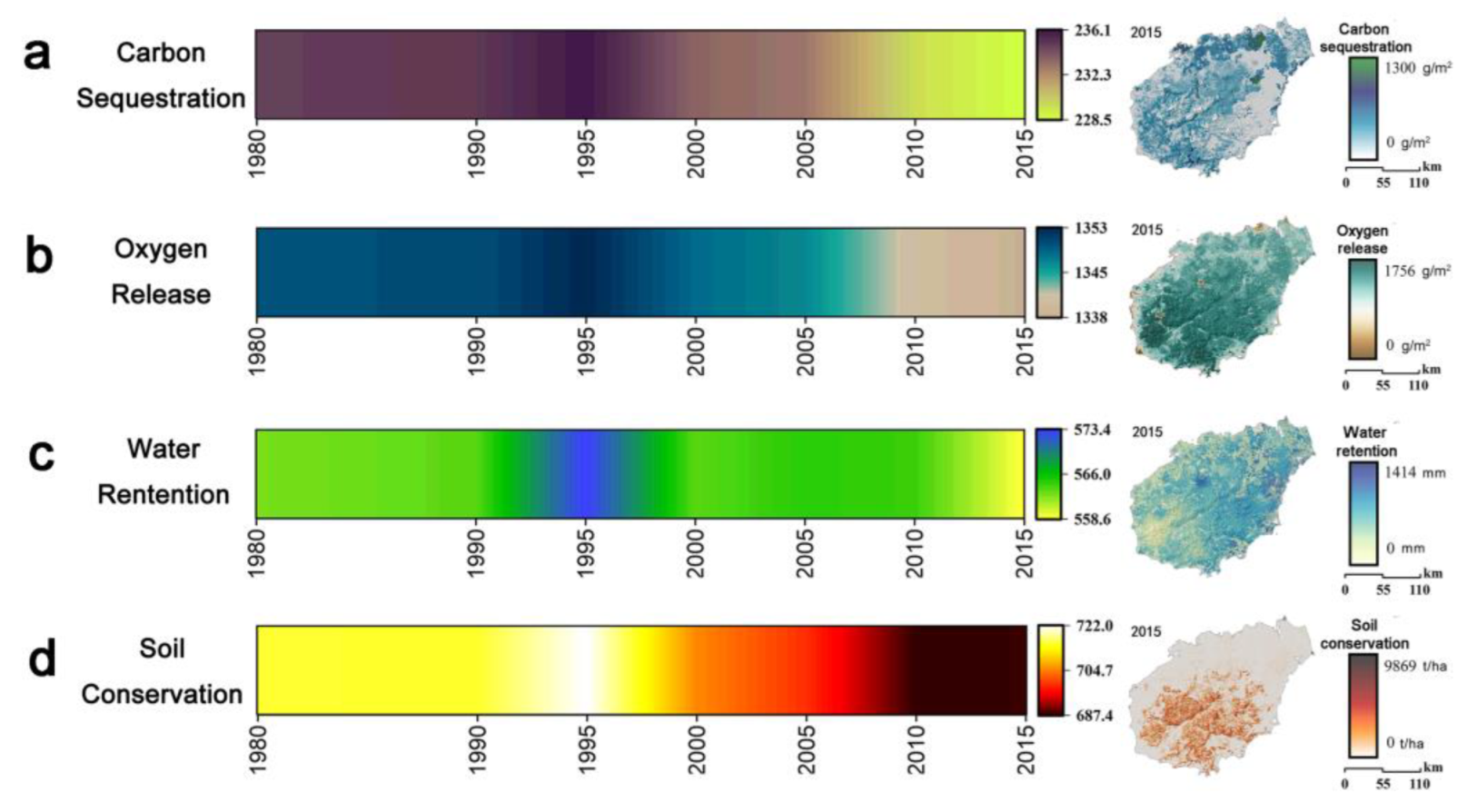
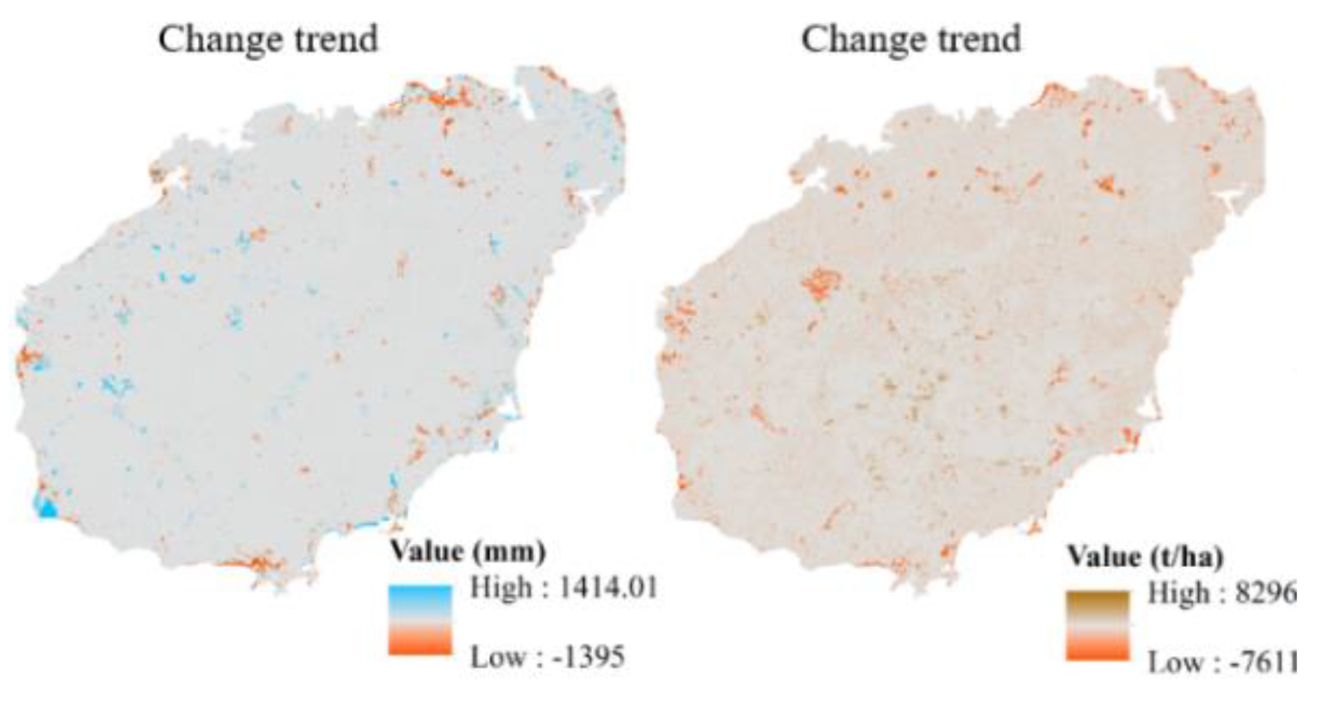

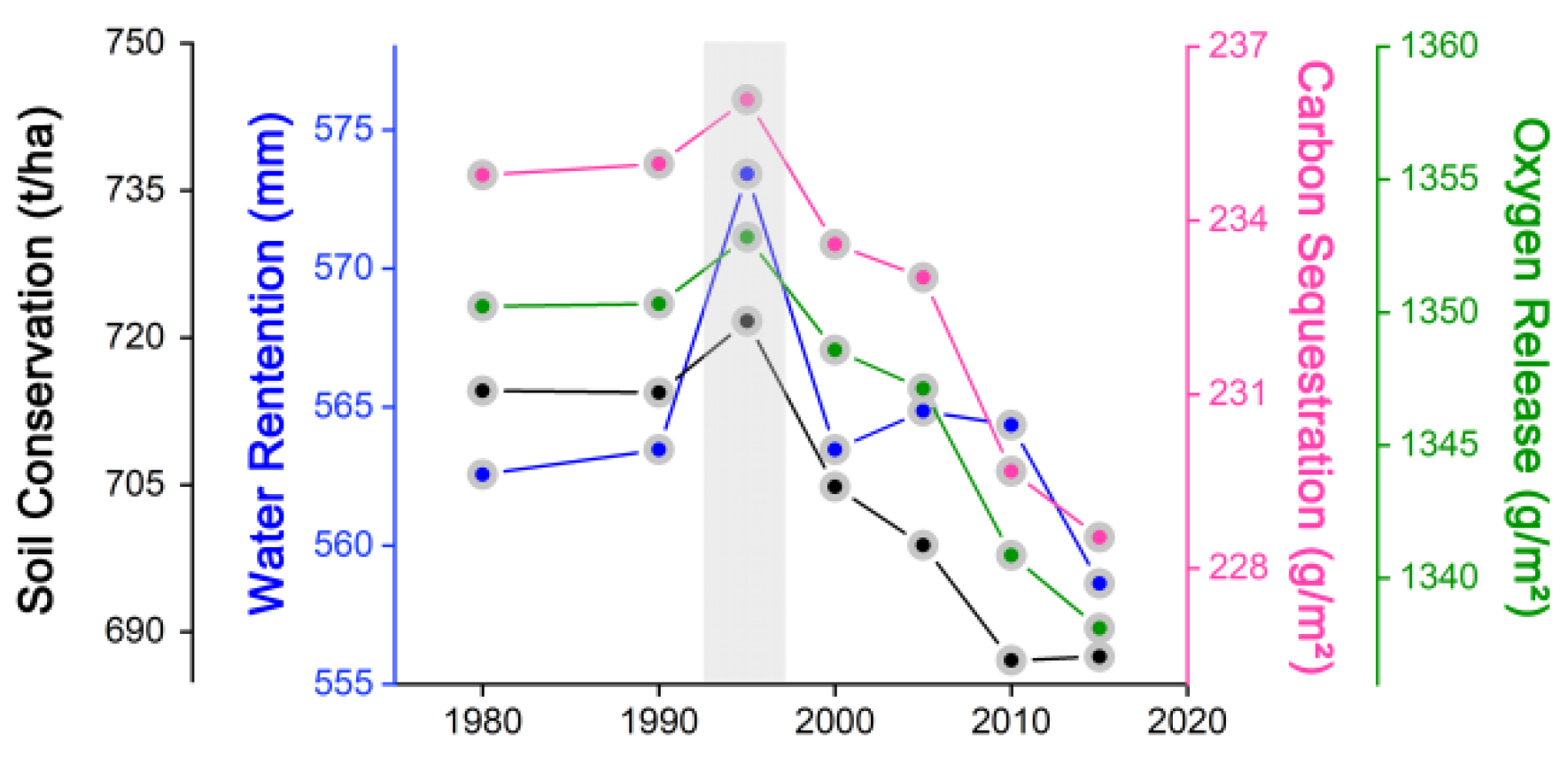
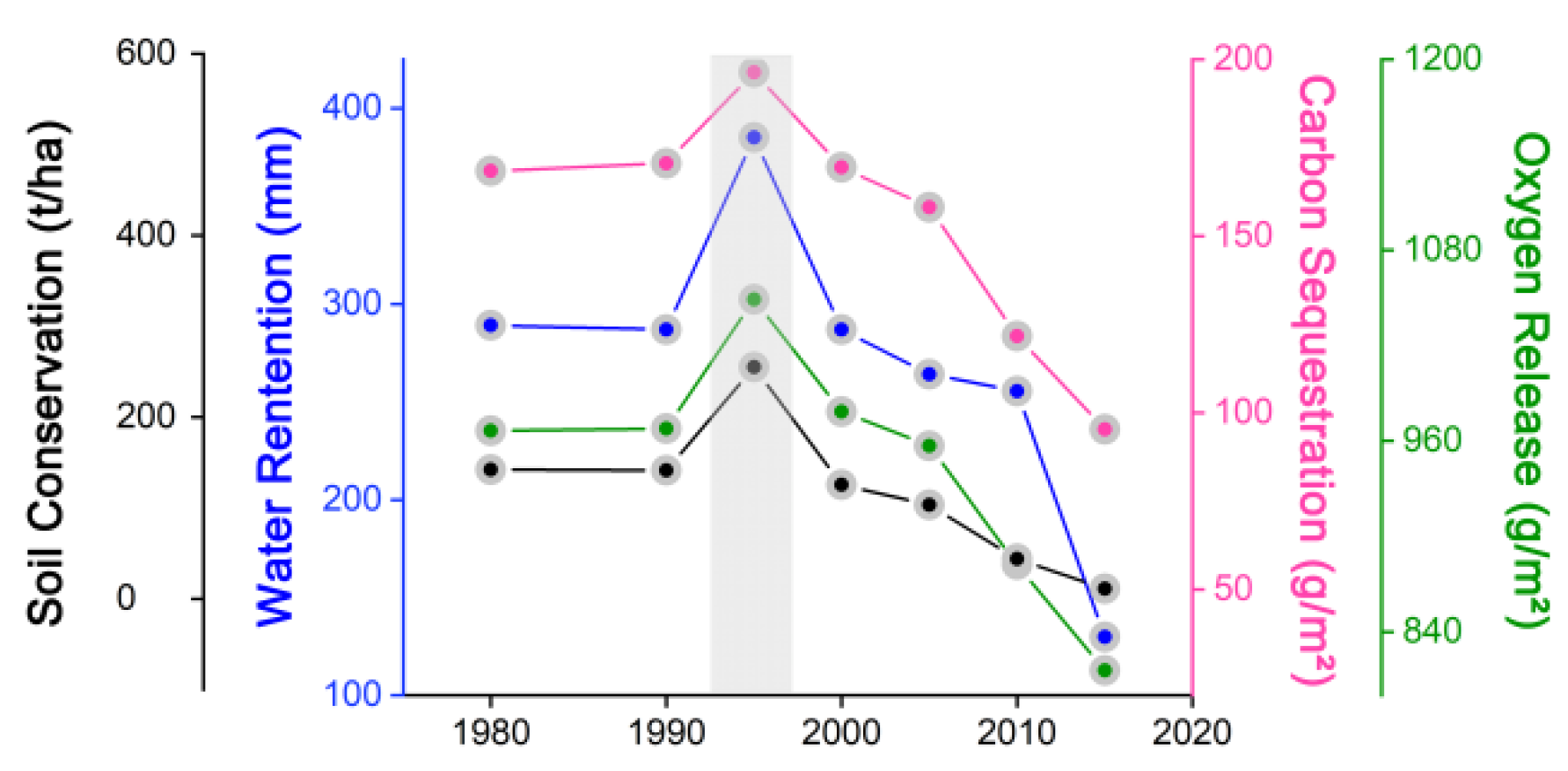

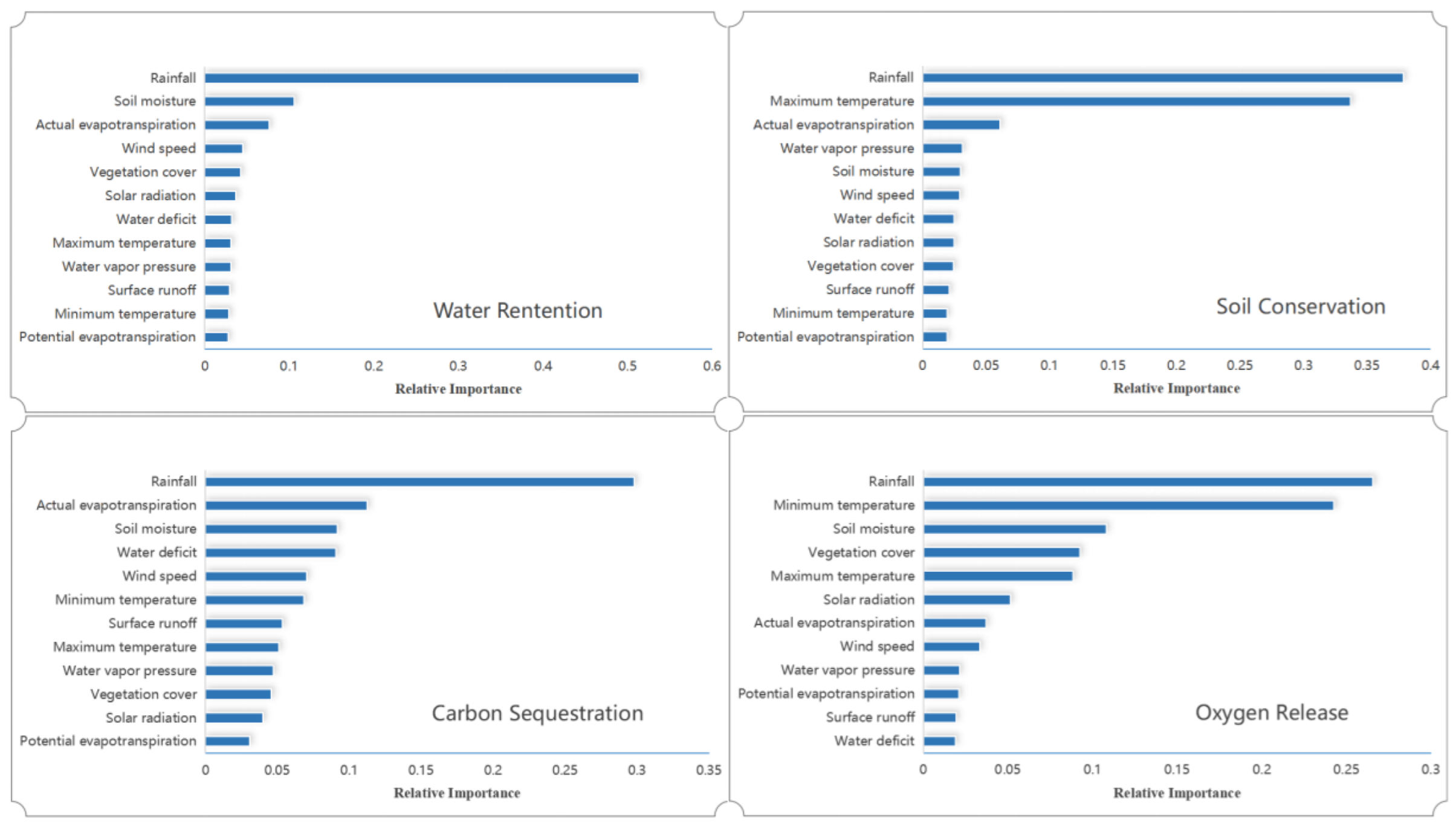
| Data Name | Spatial Resolution | Time Resolution | Source | Note |
|---|---|---|---|---|
| CLUD | 30 m | 1980–2015 | RESDC. a | Calculate ecosystem services |
| Sunshine hours | / | 1980–2015 | CMSDSSN. b | Calculate carbon sequestration |
| Soil texture | / | / | WSD. c | Calculate carbon sequestration |
| soil organic | / | / | WSD. c | Calculate carbon sequestration |
| soil capacity | / | / | WSD. c | Calculate carbon sequestration |
| National nature reserve | / | / | RESDC. a | Boundary data |
| Base pond area | / | / | WRDS. d | Calculate water retention |
| AET | 4638 m | Monthly | NCAR e | Sensitivity analysis |
| DEF | 4638 m | Monthly | NCAR e | Eco-environmental benefits analysis |
| PET | 4638 m | Monthly | NCAR e | Delineate LUBs |
| RO | 4638 m | Monthly | NCAR e | Driven analysis at spatial scale |
| SOIL | 4638 m | Monthly | NCAR e | Driven analysis at spatial scale |
| SRAD | 4638 m | Monthly | NCAR e | Driven analysis at spatial scale |
| TMN | 4638 m | Monthly | NCAR e | Driven analysis at spatial scale |
| TMX | 4638 m | Monthly | NCAR e | Driven analysis at spatial scale |
| VPD | 4638 m | Monthly | NCAR e | Driven analysis at spatial scale |
| VS | 4638 m | Monthly | NCAR e | Driven analysis at spatial scale |
| PRE | 4638 m | Monthly | NCAR e | Driven analysis at spatial scale |
| Landsat 5/8 | 30 m | 16-day | NASA. f | Calculate NDVI |
| Type | 1980 | 1990 | 1995 | 2000 | 2005 | 2010 | 2015 | 1980 to 2015 |
|---|---|---|---|---|---|---|---|---|
| Water retention (109 m3) | 23.31 | 23.34 | 23.76 | 23.34 | 23.40 | 23.39 | 23.15 | −0.16 |
| Soil conservation (109 t) | 2.90 | 2.90 | 2.93 | 2.86 | 2.84 | 2.79 | 2.79 | −0.11 |
| Carbon sequestration (106 t) | 9.68 | 9.69 | 9.73 | 9.63 | 9.61 | 9.47 | 9.42 | −0.26 |
| Oxygen release (106 t) | 56.05 | 56.06 | 56.16 | 55.98 | 55.92 | 55.64 | 55.53 | −0.52 |
Publisher’s Note: MDPI stays neutral with regard to jurisdictional claims in published maps and institutional affiliations. |
© 2022 by the authors. Licensee MDPI, Basel, Switzerland. This article is an open access article distributed under the terms and conditions of the Creative Commons Attribution (CC BY) license (https://creativecommons.org/licenses/by/4.0/).
Share and Cite
Geng, J.; Yuan, M.; Xu, S.; Bai, T.; Xiao, Y.; Li, X.; Xu, D. Urban Expansion Was the Main Driving Force for the Decline in Ecosystem Services in Hainan Island during 1980–2015. Int. J. Environ. Res. Public Health 2022, 19, 15665. https://doi.org/10.3390/ijerph192315665
Geng J, Yuan M, Xu S, Bai T, Xiao Y, Li X, Xu D. Urban Expansion Was the Main Driving Force for the Decline in Ecosystem Services in Hainan Island during 1980–2015. International Journal of Environmental Research and Public Health. 2022; 19(23):15665. https://doi.org/10.3390/ijerph192315665
Chicago/Turabian StyleGeng, Jia, Mingsheng Yuan, Shen Xu, Tingting Bai, Yang Xiao, Xiaopeng Li, and Dong Xu. 2022. "Urban Expansion Was the Main Driving Force for the Decline in Ecosystem Services in Hainan Island during 1980–2015" International Journal of Environmental Research and Public Health 19, no. 23: 15665. https://doi.org/10.3390/ijerph192315665






